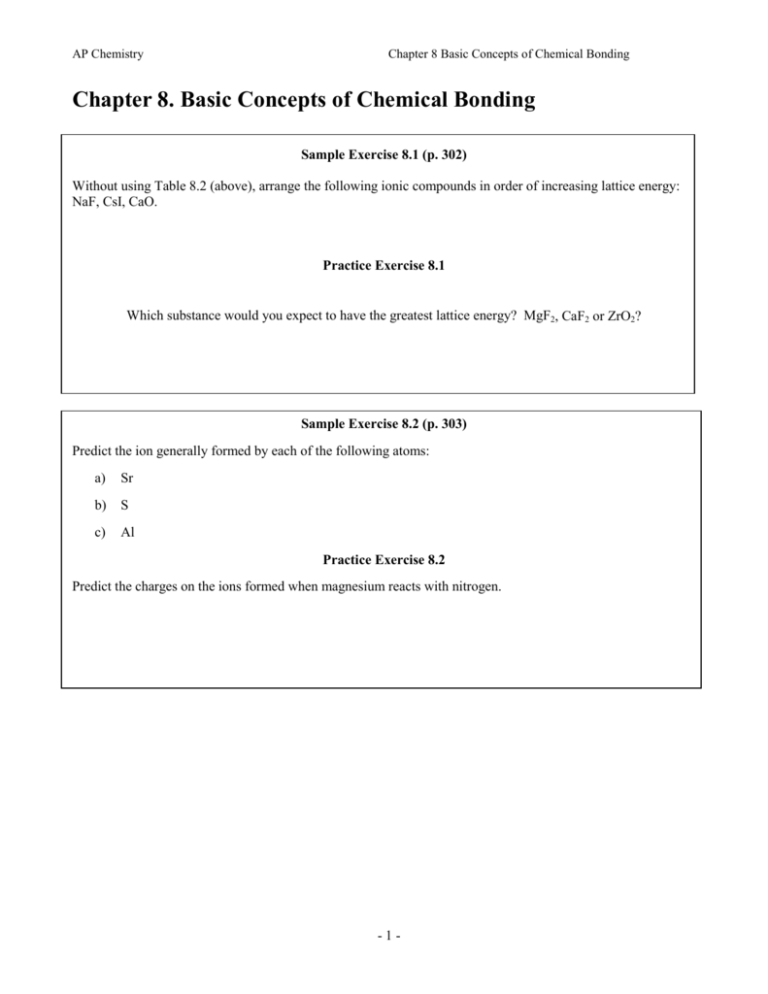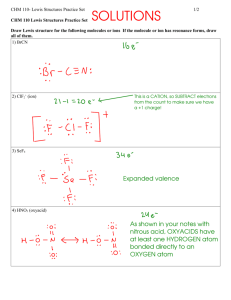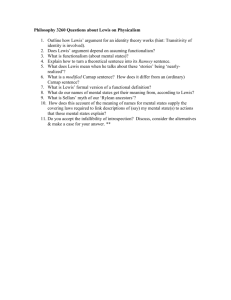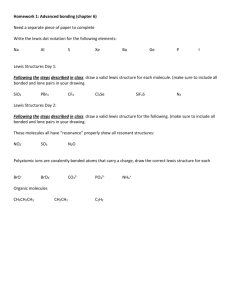Chapter 1
advertisement

AP Chemistry Chapter 8 Basic Concepts of Chemical Bonding Chapter 8. Basic Concepts of Chemical Bonding Sample Exercise 8.1 (p. 302) Without using Table 8.2 (above), arrange the following ionic compounds in order of increasing lattice energy: NaF, CsI, CaO. Practice Exercise 8.1 Which substance would you expect to have the greatest lattice energy? MgF2, CaF2 or ZrO2? Sample Exercise 8.2 (p. 303) Predict the ion generally formed by each of the following atoms: a) Sr b) S c) Al Practice Exercise 8.2 Predict the charges on the ions formed when magnesium reacts with nitrogen. -1- AP Chemistry Chapter 8 Basic Concepts of Chemical Bonding Sample Exercise 8.3 (p. 306) Given the Lewis symbols for the elements nitrogen and fluorine shown in Table 8.1, predict the formula of the stable binary compound (a compound composed of two elements) formed when nitrogen reacts with fluorine, and draw its Lewis structure. Practice Exercise 8.3 Compare the Lewis symbol for neon with the Lewis structure for methane, CH4. In what important way are the electron arrangements about neon and carbon alike? In what important respect are they different? Sample Exercise 8.4 (p. 309) Which bond is more polar: a) B-Cl or C-Cl? b) P-F or P-Cl? Indicate in each case which atom has the partial negative charge. Practice Exercise 8.4 Which of the following bonds is most polar: S-Cl, S-Br, Se-Cl, or Se-Br? -2- AP Chemistry Chapter 8 Basic Concepts of Chemical Bonding Sample Exercise 8.6 (p. 314) Draw the Lewis structure for phosphorus trichloride, PCl3. Practice Exercise 8.6 a) How many valence electrons should appear in the Lewis structure for CH2Cl2? b) Draw the Lewis structure. Sample Exercise 8.7 (p. 315) Draw the Lewis structure for HCN. Practice Exercise 8.7 Draw the Lewis structure for a) NO+ ion; b) C2H4 -3- AP Chemistry Chapter 8 Basic Concepts of Chemical Bonding Sample Exercise 8.8 (p. 316) Draw the Lewis structure for the BrO3- ion. Practice Exercise 8.8 Draw the Lewis structures for a) ClO2- ion b) PO43- ion Sample Exercise 8.9 (p. 317) The following are three possible Lewis structures for the thiocyanate ion, NCS-: a) Determine the formal charges of the atoms in each structure. b) Which Lewis structure is the preferred one? Practice Exercise 8.9 The cyanate ion (NCO-), like the thiocyanate ion, has three possible Lewis structures. a) Draw these three Lewis structures and assign formal charges to the atoms in each structure; b) Which Lewis structures should be the preferred one? -4- AP Chemistry Chapter 8 Basic Concepts of Chemical Bonding Sample Exercise 8.10 (p. 320) Which is predicted to have the shorter sulfur-oxygen bonds, SO3 or SO32-? Practice Exercise 8.10 Draw two equivalent resonance structures for the formate ion, HCO2-. Sample Exercise 8.11 (p. 324) Draw the Lewis structure for ICl4-. Practice Exercise 8.11 a) Which of the following atoms is never found with more than an octet of electrons around it: S, C, P, Br? b) Draw the Lewis structure for XeF2. -5-



